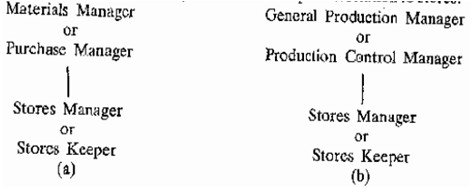Usually the following two kinds of organization are adopted in relation to stores:

In type (a) organization the stores is considered to be a materials function closely related to the receipt, and is clubbed with the purchasing or materials management department. This kind of arrangement is justified on the basis of following considerations:
- As the activities of stores are material oriented, it should report to a department whose primary interests lie in the materials and related operations.
- From the total control point of view the receiving and stores activities should be included with the rest of materials activities. This facilitates the coordination among related materials activities from the stand-point of operations. Further, the inter-relationship between stores, inventory control and purchase function will receive, proper attention in this type of organizational arrangement.
In type (b) organization the issue in the face of stores is considered to be more significant and thus it is clubbed with the production department. The arguments for such an organizational arrangement are as follows:
- In order to run the production operation smoothly the production management must have control over the immediate material supply from stores. This will ensure the smooth delivery of materials to the production centers as and when required.
- In order to avoid/discourage any kind of collusion and embezzlement of materials, the receiving and storing should be kept separate from the purchase department.
The objectives of the organizational decision regarding stores could be to store and manage the materials so that they are available in good conditions according to the peed, to efficiently supply the materials recording to production schedules, and to perform stores functions at minimum cost.
In order to fulfill the, objectives the organization will depend on the situation under consideration. In addition to the reporting, an important consideration in organizational design. is the centralization vs. decentralization. Both the centralized and decentralized organizations of stores are practiced. The advantages of centralized and decentralized stores organizations are as follows:
Advantages of centralized stores organization:
- Effective and better supervision and control
- Reduced personnel requirement, thus involving less related costs
- Better and efficient layout of stores
- Better inventory checks
- Maintenance of optimum stores
- Fewer redundant and obsolete items
- Provision of better security arrangements possible
Advantages of decentralized stores organization:
- Reduced material handling and associated work.
- Convenient for every department to draw materials
- Less risk of loss by fire etc
- Less chances of production stoppages owing to easy and prompt availability of materials

